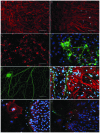A cortical astrocyte subpopulation inhibits axon growth in vitro and in vivo
- PMID: 25936767
- PMCID: PMC4464481
- DOI: 10.3892/mmr.2015.3702
A cortical astrocyte subpopulation inhibits axon growth in vitro and in vivo
Abstract
Astrocytes are the most heterogeneous and predominant glial cell type in the central nervous system. However, the functional significance of this heterogeneity remains to be elucidated. Following injury, damaged astrocytes inhibit axonal regeneration in vivo and in vitro. Cultured primary astrocytes are commonly considered good supportive substrates for neuron attachment and axon regeneration. However, it is not known whether different populations of cells in the heterogeneous astrocyte culture affect neuron behavior in the same way. In the present study, the effect of astrocyte heterogeneity on neuronal attachment and neurite outgrowth was examined using an in vitro and in vivo coculture system. In vitro, neonatal cortical astrocytes were co-cultured with purified dorsal root ganglia (DRG) neurons and astrocyte growth morphology, neuron attachment and neurite growth were evaluated. The results demonstrated that the heterogeneous astrocyte cells showed two different types of growth pattern, typical and atypical. Typical astrocytes were supportive to neuron attachment and neurite growth, which was consistent with previous studies, whereas atypical astrocytes inhibited neuron attachment and neurite growth. These inhibitory astrocytes exhibited a special growth pattern with various shapes and sizes, a high cell density, few oligodendrocytes on the top layer and occupied a smaller growth area compared with typical astrocytes. Neurites extended freely on typical supportive astrocyte populations, however, moved away when they reached atypical astrocyte growth pattern. Neurons growing on the atypical astrocyte pattern demonstrated minimal neurite outgrowth and these neurites had a dystrophic appearance, however, neuronal survival was unaffected. Immunocytochemistry studies demonstrated that these atypical inhibitory astrocytes were glial fibrillary acidic protein (GFAP) positive cells. The existence of inhibitory astrocyte subpopulations in normal astrocytes reflects the complexity of the function of astrocyte populations. In vivo, DRG neurons in grey matter did not show neurite growth, while DRG neurons survived and showed robust axon outgrowth along the corpus callosum. In conclusion, further studies on this new type of inhibitory astrocyte subpopulation may deepen our understanding of the complex biology of astrocytes.
Figures





Similar articles
-
Electrospun fiber surface nanotopography influences astrocyte-mediated neurite outgrowth.Biomed Mater. 2018 Jun 4;13(5):054101. doi: 10.1088/1748-605X/aac4de. Biomed Mater. 2018. PMID: 29762127 Free PMC article.
-
Engineering an integrated cellular interface in three-dimensional hydrogel cultures permits monitoring of reciprocal astrocyte and neuronal responses.Tissue Eng Part C Methods. 2012 Jul;18(7):526-36. doi: 10.1089/ten.TEC.2011.0587. Epub 2012 Feb 24. Tissue Eng Part C Methods. 2012. PMID: 22235832 Free PMC article.
-
Astrocytes mediate cerebral cortical neuronal axon and dendrite growth, in part, by release of fibroblast growth factor.Neurol Res. 2002 Jan;24(1):81-92. doi: 10.1179/016164102101199459. Neurol Res. 2002. PMID: 11783758
-
Role of laminin bioavailability in the astroglial permissivity for neuritic outgrowth.An Acad Bras Cienc. 2002 Dec;74(4):683-90. doi: 10.1590/s0001-37652002000400009. Epub 2003 Jan 24. An Acad Bras Cienc. 2002. PMID: 12563417 Review.
-
Mechanisms of astrocyte-directed neurite guidance.Cell Tissue Res. 1997 Nov;290(2):385-93. doi: 10.1007/s004410050945. Cell Tissue Res. 1997. PMID: 9321702 Review.
Cited by
-
The Role of bFGF in the Excessive Activation of Astrocytes Is Related to the Inhibition of TLR4/NFκB Signals.Int J Mol Sci. 2015 Dec 28;17(1):37. doi: 10.3390/ijms17010037. Int J Mol Sci. 2015. PMID: 26729092 Free PMC article.
-
Improved post-stroke spontaneous recovery by astrocytic extracellular vesicles.Mol Ther. 2022 Feb 2;30(2):798-815. doi: 10.1016/j.ymthe.2021.09.023. Epub 2021 Sep 24. Mol Ther. 2022. PMID: 34563674 Free PMC article.
-
Sigma-1 Receptors Fine-Tune the Neuronal Networks.Adv Exp Med Biol. 2017;964:79-83. doi: 10.1007/978-3-319-50174-1_7. Adv Exp Med Biol. 2017. PMID: 28315266 Free PMC article. Review.
-
Glial Cell-Axonal Growth Cone Interactions in Neurodevelopment and Regeneration.Front Neurosci. 2020 Mar 10;14:203. doi: 10.3389/fnins.2020.00203. eCollection 2020. Front Neurosci. 2020. PMID: 32210757 Free PMC article. Review.
-
Non-integrin laminin receptor (LamR) plays a role in axonal outgrowth from chicken DRG via modulating the Akt and Erk signaling.Front Cell Dev Biol. 2024 Jul 31;12:1433947. doi: 10.3389/fcell.2024.1433947. eCollection 2024. Front Cell Dev Biol. 2024. PMID: 39144252 Free PMC article.
References
-
- Kettenmann H, Ransom BR, editors. Neuroglia. 2nd edition. Oxford University Press; New York: 2005. The concept of neuroglia: a historical perpspective; pp. 1–9.
MeSH terms
Substances
LinkOut - more resources
Full Text Sources
Other Literature Sources
Miscellaneous

